
* Had the Phantom only served with US forces, it would have still been an important aircraft, but it also flew with roughly a dozen foreign air arms, in a few cases in the form of custom variants built specifically for those nations. This chapter provides a history of the Phantom in foreign service.
* The first foreign user of the Phantom was the UK. In the late 1950s and through much of the 1960s, successive British governments decided that it made no sense for the UK to spend large amounts of money to develop their own sophisticated weapons, and that it was wiser to "buy American". The results of this policy were to eliminate a number of very promising aircraft development programs and damage the British defense-aerospace business sector for decades, but at least the Phantom was a beneficiary.
On 1 July 1964, the British government approved the purchase of the "Phantom FG.1 (Fighter Ground-Attack Mark 1)", or "F-4K" in McDonnell nomenclature, for the Royal Navy's Fleet Air Arm (RN-FAA). A year later, on 1 July 1965, a second deal was closed on the "Phantom FGR.2 (Fighter Ground-Attack Reconnaissance Mark 2)" or "F-4M" for the Royal Air Force (RAF).
In both cases, the Phantom had been selected as an alternative to a proposed supersonic vertical take-off fighter, the Hawker P.1154. The P.1154 had proven a nonstarter -- though in this case less because of governmental bumbling than because the Royal Navy and the RAF could not, would not, agree on a common configuration. McDonnell salesmen had been there to fill the void, since the company had been courting the RN and the RAF with the Phantom since the spring of 1960. McDonnell had even considered how to adapt the big fighter to British Rolls-Royce Spey bypass jet engines, used in the Hawker-Siddeley Buccaneer naval strike aircraft, in place of the Phantom's usual J79 turbojets.
The Royal Navy was happy with the idea of obtaining the Phantom, since it was regarded as an excellent replacement for the service's existing de Havilland Sea Vixens in the fleet interceptor role, and would also be serviceable for maritime strike. The RAF obtained the Phantom primarily for the strike role to replace the Hawker Hunter, and was not so happy about the deal. The service had really wanted the P.1154, and to an extent the Phantom was pushed on the service by the government as a means of reducing unit costs by increasing the volume of the Royal Navy purchase. Of course, British industry was particularly unhappy about such a major commitment to an American aircraft, and so the government threw them a bone by specifying that the British Phantoms would feature substantial British content -- though the aircraft would still be built in the US.
* The FAA Phantom FG.1 was derived from the F-4J, but featured:
The first of two "YF-4K" FG.1 prototypes flew on 27 June 1966, and a total of 52 FG.1s were procured, including the prototypes. It is an indication of the drastic draw-down of the FAA force in the 1960s that the original intent had been to obtain 140 -- and in fact fourteen FG.1s never even saw FAA service, being transferred immediately to the RAF on delivery.
Royal Navy pilots received their operational introduction to the type on the US Navy carrier USS SARATOGA in the fall of 1969, and the type served on British carriers for ten years. On 27 November 1978, ten FAA Phantom FG.1s launched off the HMS ARK ROYAL for the last time. The carrier was coming home on her final voyage. The Phantom FG.1 was the last conventional take-off carrier fighter flown by the Royal Navy. There was an anxious period from December 1978 to June 1979 where FAA fighter pilots had nothing to fly, until they were finally relieved by the arrival of the Hawker Sea Harrier.
* The RAF Phantom FGR.2 was a modification of the FG.1, with AN/AWG-12 radar, another variant of the AN/AWG-10; additional avionics, such as a Ferranti INS; a strike camera; and deletion of some carrier gear, such as the long folding nose gear. The RAF had wanted to use the J79 engine instead of the Spey, but the service was forced to go along with the Rolls-Royce engine for the sake of commonality with the FAA Phantoms.
The first of two "YF-4M" FGR.2 prototypes performed its initial flight on 17 February 1967, and a total of 118 Phantom FGR.2s were procured, including the prototypes. The FGR.2s were initially operated in the strike role, carrying SNEB / Brandt 68-millimeter (2.7-inch) unguided-rocket pods; British dumb bombs; Hunting Engineering BL755 cluster bombs; and the SUU-23/A 20-millimeter centerline cannon pod. They were also operated on the European Central Front with US-owned tactical nuclear weapons, under a "dual-key" US-UK weapons control scheme.
In addition, a number of RAF Phantoms were wired to carry a centerline reconnaissance pod, built by EMI of Britain. The EMI recce pod was very sophisticated, carrying a Texas Instruments RS-700 infrared scanner; an EMI P391 SLAR; and a suite of cameras. Camera fit varied, but a typical configuration was five cameras: a forward-looking camera, twin oblique cameras, a vertical camera, and a stereoscopic vertical camera. RAF recce Phantoms could also carry a photoflash pod built from a modified drop tank. The photoflash pod was not often used, since it was only effective at low altitudes, and the flares attracted unwanted attention. RAF recce Phantoms remained fully combat-capable, carrying AAMs, bombs, and other stores.
RAF Phantoms underwent a structural strengthening program in the late 1970s that also involved some minor equipment updates, and from 1987 on 75 FGR.2s were rewinged to give them a few years of additional service.
* When the Phantom FG.1 was phased out of Royal Navy service in 1977, the survivors were passed on to the RAF. Since the FG.1 lacked the nav-attack systems for overland attack, the FAA Phantoms were used in the air-defense role in RAF service. The Royal Navy provided flight training for RAF pilots flying the FG.1 to ensure quick introduction to service. RAF FG.1s often intercepted and escorted Soviet ocean-patrol aircraft in the North Sea, the most common type being the Tu-95 "Bear". That was not particularly exciting duty, though it did have some amusing aspects, as one FG.1 pilot, Wing Commander Dave Wood, later recalled:
BEGIN_QUOTE:
In the daytime the mission was straightforward, and there was time for a little play with the "Bears". As far as the Soviets went, this got a little out of hand, for they started putting a KGB officer on board to stop the crew waving at us.
Some "Bear" variants had a crawlway between the front and back compartments -- a long and uncomfortable journey that involved clambering over unprotected wing spars and other obstructions. We soon worked out that by moving our jet forwards and backwards we could get this poor idiot to spend hours crawling back and forth down this tunnel, just to stop the crew from waving at us.
END_QUOTE
Following the Falklands War in 1982, Prime Minister Margaret Thatcher's government decided to station RAF Phantoms there in defense of the islands. However, the RAF's Phantoms were fully tasked in support of NATO and couldn't be spared, and so in 1983 Britain ordered 15 ex-US Navy F-4J Phantoms to augment RAF stocks, allowing a Phantom squadron to be sent to the Falklands. The "new" aircraft received the designation "F-4J(UK)". They were originally provided essentially "as-was", but they were gradually refitted with more and more British kit, including some gear scavenged from surplus Phantom FG.1s.
At first, RAF pilots regarded the isolated Falklands as a hardship duty post, but they were provided with a "coastel", a floating hotel, with comfortable accommodations, and also found that the isolation meant that they could fly with very few restrictions in largely empty airspace. The stories of British pilots flying back, forth, and then over flocks of penguins to make them fall over backwards appear to be tall tales, however -- penguins are not that bird-brained.
In 1974, the SEPECAT Jaguar began to replace the Phantom FGR.1 for the strike role in RAF service, and the Phantom was then assigned strictly to air defense, replacing the English Electric Lightning. In the late 1980s, the Phantom FGR.1 began its final phase-out from RAF service as it was replaced by the Tornado ADF, and the last RAF Phantoms went out of service in 1992.
* The British Phantoms could be distinguished from their American cousins by their wider and shorter engine exhausts. Beginning in 1975, RAF Phantoms were fitted with a distinctive rectangular antenna for a Marconi ARI 18228 RWR, attached to the top of the tailfin.
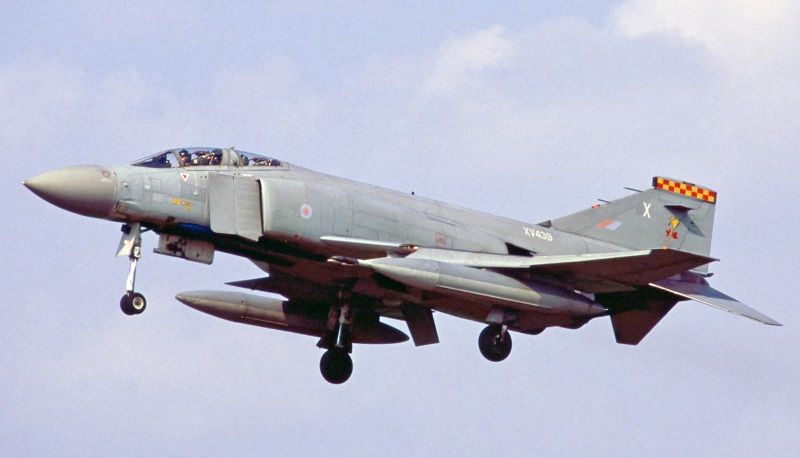
The changes ordered by the British government led to a considerable increase in the cost of the aircraft -- and worse, although the Spey was more powerful than the J79 and had greater fuel economy, the British would probably have been better off to have stayed with the J79. The match between an engine and an airframe can be surprisingly touchy, and the Spey-powered Phantom turned out to be a textbook example of the troubles that can arise when trying to mate an engine to an aircraft that wasn't really designed for it,
The British Phantoms required substantial airframe modifications, with the rear fuselage width increased to accommodate the Speys, and 20% larger intake ducts to provide the greater airflow required by the Rolls-Royce engines. Even then, the Speys were temperature-redlined to Mach 1.9, due to cost-reduction measures imposed on Rolls-Royce that dictated use of cheaper metals. Between the airframe changes, which undermined the Phantom's "area ruling", and the limitations of the engines, the British Phantoms were sometimes described, most likely by a certain famously caustic senior British aviation writer, as the "most powerful, most expensive, and slowest Phantoms in the world."
However, although the 1960s were the great age of British weapons procurement fiascos, the selection of the Spey was by no means a case of excessive nationalism at work, and the problems seem to have sometimes been exaggerated. Since British carriers were smaller than American carriers, FAA Phantoms had to have more power to get off the decks, both in terms of drive for the BLC system and greater thrust. In fact, the Spey-powered F-4s had superior acceleration and rate of climb relative to J79-powered F-4s, outpacing US Navy Phantoms during their stint on the USS SARATOGA until their American cousins could catch up and then fly past them.
The British Phantoms also had better low-level performance, an absolute benefit for RAF strike pilots who normally flew above the treetops, and enjoyed a 10% greater radius of action. Ground-attack pilots particularly liked knowing that they could take on adversary fighters at level or superior odds. The fact that the Phantom could carry four AAMs in the fuselage recesses without interfering with carriage of attack munitions was a significant advantage.
As a strong plus, from 1979 on the British Phantoms carried the UK-built "Sky Flash" AAM in preference to the American-made Sparrow. Fit of the Sky Flash to the Phantom was simple, because the missile was based on the Sparrow airframe, with a British-built seeker. The Sky Flash was much superior to US-built Sparrows of the time, helping spur the Americans to catch up with better Sparrow variants of their own.
The RAF's initial misgivings about the type gradually grew into admiration and affection, one RAF pilot concluding: "All in all, the Phantom was an excellent aircraft." It was retired with regrets. A number of "Yanks", such as the C-47 Dakota and the P-51 Mustang, have served with distinction wearing British roundels, just as the British Canberra and Harrier have served with distinction wearing the red-white-&-blue in return. The Phantom was one of the significant American eagles in British colors, proving capable enough to overcome the nationalism that sometimes puts the two nations at odds.
BACK_TO_TOP* In the late 1960s, the West German Luftwaffe was considering the replacement of their Lockheed F-104G and RF-104G Starfighters. To this end, in 1968 the Germans joined a collaboration with Britain and Italy to develop a "Multi-Role Combat Aircraft (MRCA)". The MRCA program would become the Panavia Tornado, a mainstay of European defense, but it became apparent that the MRCA would not be available in time to replace the Starfighters. In fact, as it turned out, the Luftwaffe would not get their first Tornado until the fall of 1981.
As an interim measure, to replace the RF-104Gs, in May 1968 the Luftwaffe ordered 88 RF-4Es under the PEACE LOOKOUT program. Initial deliveries were in 1971. The RF-4Es were initially unarmed, but later modified for a secondary ground-attack role. To replace the F-104G, the Luftwaffe then ordered 175 "F-4Fs" -- F-4Es optimized for air superiority -- under the PEACE RHINE program.
The F-4F had begun life in the late 1960s as a McDonnell concept for a single-seat "F-4EF" air-superiority fighter, with a lighter airframe; no folding wings; only six fuel tanks; and smaller weapons load. The Luftwaffe selected a less drastic derivative of the F-4E that retained two seats and folding wings, but featured:
The initial F-4F flew in Saint Louis on 18 March 1973. Deliveries to Germany began in September 1973, with the last of the 175 delivered in April 1976. No doubt the combination of reduced weight and late-model engines made the F-4Fs particularly zippy members of the Phantom family.
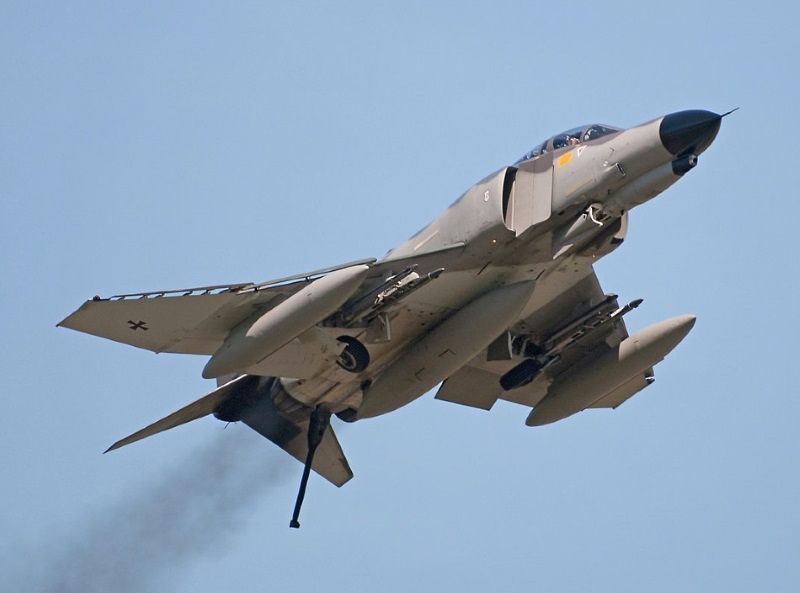
Even before the final delivery, the Luftwaffe had realized that they had been too severe in eliminating gear from the Phantom, and instituted an update program to:
The update program was performed by MBB, with the first upgraded aircraft returned to the Luftwaffe in November 1980 and the last returned in 1983.
* At full strength, the Luftwaffe had two wings of F-4Fs operating as fighter-bombers and two wings operating in the air defense role. The Luftwaffe conducted flight training for their F-4Fs at George AFB in California, originally setting aside 12 F-4Fs stateside for that purpose. These F-4Fs were taken to Germany in 1977 as attrition replacements, and the Germans bought 10 F-4Es to take their place.
The RF-4Es were finally withdrawn from service in 1993, having been replaced in the reconnaissance role by Tornados obtained by the Luftwaffe from the German naval air arm, the MarineFlieger. The Tornado similarly replaced the F-4F in the fighter-bomber role, with the transition complete by 1990.
However, the F-4F remained active in the fighter role into the new millennium. The Luftwaffe had hoped to introduce the new Eurofighter "Typhoon", another European international collaboration, into service in the 1990s -- but as with the Tornado, development of the Eurofighter proved troublesome. As another interim measure, 110 of the F-4Fs were given substantial upgrades in the early 1990s under the "KampfWertSteigerung (KWS)" AKA "Improved Combat Effectiveness (ICE)" program.
The KWS involved adapting the F-4Fs to carriage of the "AIM-120 Advanced Medium Range AAM (AMRAAM)", a much improved Sparrow derivative; and replacing the Hughes AN/APQ-120 radar with the Hughes AN/APG-65GY pulse-doppler radar. The AN/APG-65 had originally been developed for the McDonnell-Douglas F/A-18 Hornet, and was needed for use of the AMRAAM; the new F-4F radars were built under license in Germany. The upgrade also featured new avionics, such as new cockpit displays; a ring-laser gyro INS; new IFF and air-data computer; and a MILSTD 1553B bus to link the avionics together. In addition, the KWS F-4Fs were later fitted with a Litton AN/ALR-68 RWR.
The 37 other surviving Luftwaffe F-4Fs were given a similar upgrade, but retaining AN/APQ-120 radar and without AMRAAM capability. The updates were performed by Deutsche Aerospace AG (DASA), which had previously been MBB. The KWS updates were completed in 1998. The Luftwaffe Phantoms served through the next decade, but they were formally withdrawn from service in 2013.
The Luftwaffe's F-4Es were moved from George AFB to Holloman AFB in New Mexico in 1996, and were soon replaced by KWS F-4Fs rotated from Germany since the F-4Es were no longer representative of the Luftwaffe's Phantoms. Luftwaffe Phantoms also performed low-level training at Canadian Forces Base Goose Bay. With the introduction of the Typhoon to Luftwaffe service, the need for training new pilots on the F-4F evaporated, and the Holloman Phantom squadron was finally disbanded in late 2004 -- though training continued there with the Tornado.
BACK_TO_TOP* The Israel Defense Force Air Force (IDF-AF) obtained a number of Phantoms, eventually acquiring 42 new-build F-4Es, 162 ex-USAF F-4Es, and 12 new-build RF-4Es. At least some of the Israeli F-4Es were fitted with TISEO, making them among the few export Phantoms with this item. The first F-4Es arrived in September 1969, and the type was given the Hebrew name of "Kurnass (Sledgehammer)", while the RF-4E became the "Oref (Raven)".
The 1967 Six-Day War had been a smashing Israeli victory and a resounding Arab defeat, but it did not result in a peace treaty, and low-level fighting continued for several years. The new Phantoms were put into action immediately, making incursions into Egypt to hit missile sites and other targets. On 4 October 1969, two F-4Es conducted Operation HED (REVERBERATION), in which they screamed low over Cairo, engaged afterburners, and punched through Mach 1 over Egyptian President Nasser's house. The sonic boom blew out windows all over the city.
The Egyptians were determined to deal with such humiliations, and in early 1970 Nasser, though in failing health, went to Moscow to ask the Soviets for help. Moscow was willing to assist, sending quantities of SAMs and the latest MiG-21s to Egypt, along with Soviet crews to handle them. The Soviets and the Israelis avoided contact with each other for months, but on 25 July 1970, two Soviet-piloted MiG-21s jumped an IDF-AF A-4 Skyhawk. The Skyhawk was damaged by an AAM, but the pilot managed to crash-land it back in Israel.
Israeli pilots had been waiting for something like that to happen, and on 30 July they sent two reconnaissance aircraft into Egyptian airspace, with Phantoms and French Mirage fighters hanging back discreetly at a distance. MiG-21s came up to pursue the reconnaissance aircraft; the Israeli fighters immediately jumped them. Much to the surprise of the Israelis, the Soviet pilots proved poorly trained, and five MiG-21s were lost with no Israeli losses. Eight days later Nasser, who had a month left to live, agreed to a UN ceasefire.
Israeli Phantoms didn't do so well in the next round of fighting, the Yom Kippur War in the fall of 1973. Although the IDF-AF obtained clear air superiority over Egyptian and Syrian fighters, the Arabs had been armed with improved Soviet SAMs and had been well-trained in their use, shooting down at least 33 F-4s. It is believed that the US may have supplied some replacement Phantoms in the NICKEL GRASS airlift organized to help rescue the Israelis, but if so the details remain a secret. With the arrival of the F-15 and F-16 fighters later in the 1970s, the Phantom was relegated to the strike role, performing attacks on Syrian positions in Lebanon during the Israeli intervention in that country in 1982.
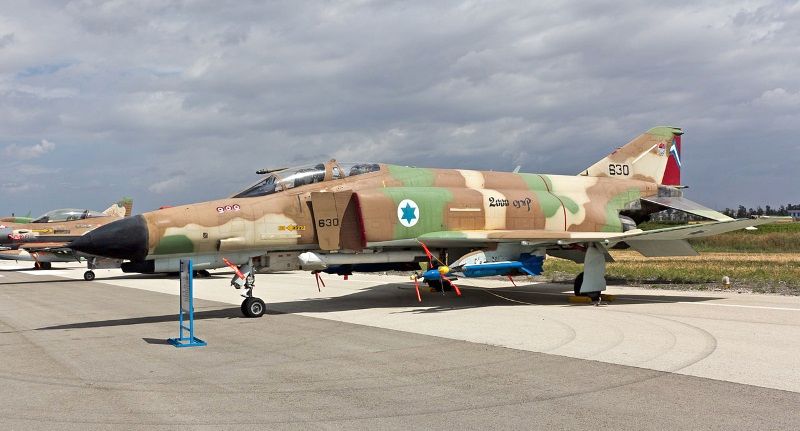
* The Israelis took every opportunity to improve the combat capability of their Phantoms. They were qualified for carriage of a wide variety of weapons, including the AGM-84A Harpoon and Rafael Gabriel III anti-shipping missiles. They also wired their RF-4Es for carriage of Sidewinders or Israeli-built heatseeking AAMs. Since the Sidewinder provides its own target acquisition using its infrared seeker, with the only cockpit indicator required being the tone in the pilot's headphones, it was a simple upgrade.
The most drastic modifications were performed to three IDF-AF F-4Es that were rebuilt to the "RF-4E(S) Peace Jack" reconnaissance configuration by General Dynamics (GD). In the late 1960s, the Israelis wanted to obtain the Martin RB-57F long-range, high-altitude reconnaissance aircraft from the US, but the US State Department refused to grant permission. In compensation, in 1971 the Israelis were allowed to buy a pod-mounted version of the long-range GD "High Altitude Camera (HIAC)" for use with Israeli Phantoms.
The HIAC was most useful at altitudes above the ceiling of an ordinary Phantom, and in 1972 the Israelis asked GD what might be done to improve matters. GD came back with a concept for a highly modified Phantom, provisionally designated the "F-4X", featuring J79s modified by GD to incorporate water-methanol injection, allowing the aircraft to reach Mach 2.4 and an altitude of 23,800 meters (78,000 feet).
The GD engineering team received a stock F-4E in December 1974 and mocked up the revised engine installation, but they needed USAF assistance to do the job, and the Air Force was not enthusiastic about the F-4X. USAF brass worried that Congress might see it as a cheaper alternative to the McDonnell Douglas F-15 Eagle, then emerging as the service's new heavy fighter. GD finally abandoned the engine update effort. The Israelis settled for fitting a highly modified nose containing the HIAC to the F-4E, and so the Peace Jack RF-4E(S) was born.
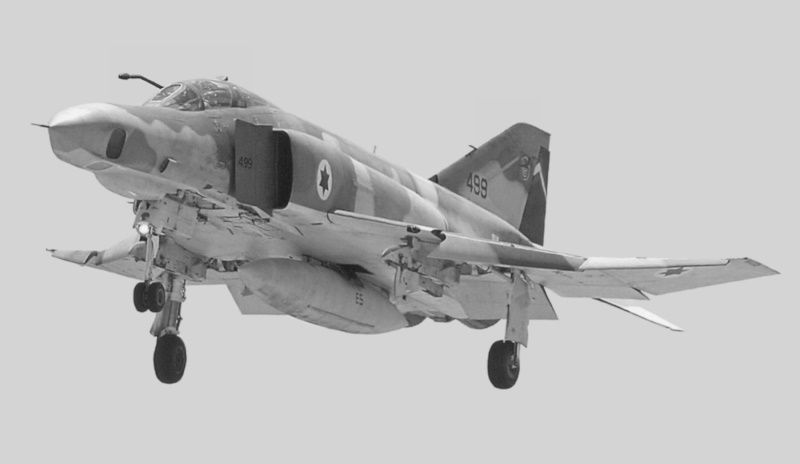
The HIAC was mounted on a rotating assembly, with a fixed downward-staring camera mounted behind it. The Peace Jack Phantoms were also believed to sometimes carry electronic intelligence (ELINT) pods on stores pylons. One of the three Peace Jack Phantoms was apparently lost in action in 1982.
* To keep their Phantoms in service, in the mid-1980s the IDF-AF decided to upgrade them to an improved "Phantom 2000" configuration to keep them combat-ready for the rest of the century. The updates were performed by Israel Aircraft Industries (IAI), and featured structural upgrades to extend service life; a complete rewiring; installation of a MILSTD 1553B avionics system bus; a fixed inflight refueling probe; and a new, comprehensive avionics suite, featuring a Norden/UTC AN/APG-76 multimode radar, a modern mission computer, new nav-attack systems, new countermeasures systems, and "hands on throttle and stick (HOTAS)" controls. The update also allowed carriage of the Rafael "Popeye" heavy ASM.
The first prototype Phantom 2000 flew in August 1987, followed by initial delivery to the IDF-AF in 1989, though radar upgrades didn't begin until 1992. By that time, the F-15 and F-16 were generally replacing the Phantom in IDF/AF service, and though the Phantom 2000 program originally envisioned the update of 130 aircraft, in practice only 55 aircraft were reworked.
IAI also planned a second level of update, designated the "Super Phantom 2000", in which the aircraft were to be fitted with twin Pratt & Whitney (P&W) PW1120 afterburning bypass jet engines. The PW1120 was a derivative of the P&W F100 used on the F-15 and F-16, and was developed for the IAI "Lavi (Lion)" fighter program, which was ultimately canceled. The PW1120 was shorter and lighter than the J79 but almost the same diameter, making installation in the Phantom relatively straightforward. The PW1120 offered 25% more dry thrust and 30% more afterburning thrust than the J79.
A single Super Phantom 2000 prototype was implemented and flown at the Paris Air Show in 1987, but there were no takers. The cost of the engine update was a significant fraction of the cost of an entirely new aircraft, and nobody thought it sounded like a good deal. Boeing considered a similar Phantom update and abandoned the idea. Israel retired the last of their Phantoms in the summer of 2004, with some passed on to Turkey.
BACK_TO_TOP* Turkey was a major Phantom operator, having received under the PEACE DIAMOND program 40 new-build F-4Es from 1974; then 32 new-build F-4Es and 8 RF-4Es; 30 hand-me-down F-4Es in the early 1980s; and 80 more hand-me-down F-4Es in the late 1980s and early 1990s. The Turks then received 32 ex-Luftwaffe RF-4Es from 1992,
In 1995, the Turkish government signed an agreement with IAI of Israel to update about 54 of Turkey's F-4Es. The update program included structural strengthening and an avionics improvement package similar to the Israeli Phantom 2000 configuration, but with some changes as per Turkish requirements, leading to the designation of "Phantom 2020". As with Israeli Phantom 2000s, Turkish Phantom 2020s had the ability to carry the big Popeye ASM, that weapon having been acquired by the Turks.
There were some political delays in implementing the update program, but the first Phantom 2020 flew in 1999. The first 26 aircraft were rebuilt in Israel, and the other 28 in Turkey. Also in 1999, the THK issued a requirement for updating their RF-4Es. As mentioned above, Turkey did obtain some machines retired by Israel, but the fleet is being gradually drawn down. However, the F-4 will still remain in Turkish service through the 2020s.
* Under the PEACE ICARUS program, Greece received 56 F-4Es and 8 RF-4Es, all new-build aircraft, the first of them being received by the Elliniki Polimiki Aeroporia (EPA, the Greek Air Force) in March 1974, and deliveries continuing through 1978. The EPA received another batch of 28 ex-USAF F-4Es in 1991 and a batch of 29 ex-Luftwaffe RF-4Es, nine of them for spares cannibalization, in 1993. Some sources claim that Greek Phantoms were involved in air combat with Turkish Phantoms during a squabble over Cyprus in 1977, the Greeks getting the worst of it.
Some of the older EPA F-4Es were fitted with the Zeus RWR system, featuring antennas distributed over the aircraft, including distinctive antennas fitted just behind the intakes. The Zeus RWR was capable enough to allow these aircraft to operate in the defense-suppression role, and the EPA acquired AGM-88A HARMs for that purpose.
After receiving the additional Phantoms in the early 1990s, the EPA also came up with a requirement for a comprehensive upgrade for some of their F-4Es, conceptually similar to the KWS upgrade for Luftwaffe Phantoms to provide AIM-120 AMRAAM compatibility and modern avionics. In fact, DASA originally proposed almost exactly the same configuration as KWS-ICE in response to the initial EPA request. IAI proposed an upgrade based on their Phantom 2000, but the Greeks rejected that proposal because of Israel's close ties with Turkey. DASA eventually triumphed over Rockwell in a second round of proposals, ironically collaborating with Elbit of Israel, and won a contract for update of 39 EPA F-4Es in 1997.
The update was generally similar to the Luftwaffe KWS-ICE update, with AN/APG-65 radar and AMRAAM carriage at the core, but Elbit was able to provide more cost-effective components for the other avionics improvements. The initial two conversions were performed in Germany, with the first performing its maiden flight on 28 April 1999; the remainder of the updates were performed by Hellenic Aerospace Industries (HAI) in Greece, using kits supplied under the contract.
HAI also performed structural upgrades on EPA Phantoms, including a number of aircraft not put through the DASA upgrade program. The EPA has also acquired a range of new weapons and systems for their updated Phantoms, in particular the Israeli Rafael Litening targeting pod. However, the Phantom is on the fade in Greece, and the F-4 will be out of service in a few years.
* Under the PEACE ALFA program, 36 F-4Cs were transferred from the USAF to Spain in 1971, followed by an additional batch of four F-4Cs and four RF-4Cs in 1978. All the surviving F-4Cs were withdrawn from service with the Ejercito del Aire (EdA / Spanish Air Force) in 1990, to be replaced by new McDonnell Douglas F/A-18 Hornets.
The EdA acquired a second batch of eight ex-USAF RF-4Cs in 1989, these aircraft having refinements such as J79-GE-15E "smokeless" engines, and then a third batch of six ex-USAF RF-4Cs. The initial four RF-4Cs were then retired.
The third batch of six RF-4Cs featured avionics improvements, as well as chaff-flare dispensers and AIM-9L Sidewinder capability. The second batch of eight RF-4Cs was brought up to this standard by the Spanish CASA firm.
In 1996, the EdA decided to institute a phase-two upgrade program for all 14 of their surviving RF-4Cs, featuring AN/APQ-172 navigation radar, other avionics updates, and a bolt-on Israeli flight refueling probe. That kept the RF-4Cs going into the next century, but they were finally retired in 2002.
BACK_TO_TOP* In 1968, the Japanese Air Self-Defense Force (JASDF) decided to standardize on the F-4E as their first-line fighter. The service obtained two F-4Es in 1971, delivered from the US as part of a deal for license manufacture by Mitsubishi of Japan. Mitsubishi then assembled nine F-4Es from kits supplied by McDonnell Douglas; followed by two F-4Es that were built from forward fuselage kits, with the other assemblies built by Mitsubishi; and then 127 F-4Es that were completely built by Mitsubishi.
These were the only Phantoms to be built under license. The Japanese F-4Es were referred to as "F-4EJs", and had some slight differences from a "stock" F-4E, mostly in the deletion of some attack systems and inflight refueling capability judged incompatible with the Japanese military philosophy of "self-defense"; fit of a Japanese-built RWR; and compatibility with Japanese "AAM-2" heat-seeking missile, similar in general configuration to the Sidewinder, but derived from the Israeli Rafael-Python AAM series. The last F-4EJ was delivered from Mitsubishi on 20 May 1981, being the last of 5,195 Phantoms built.
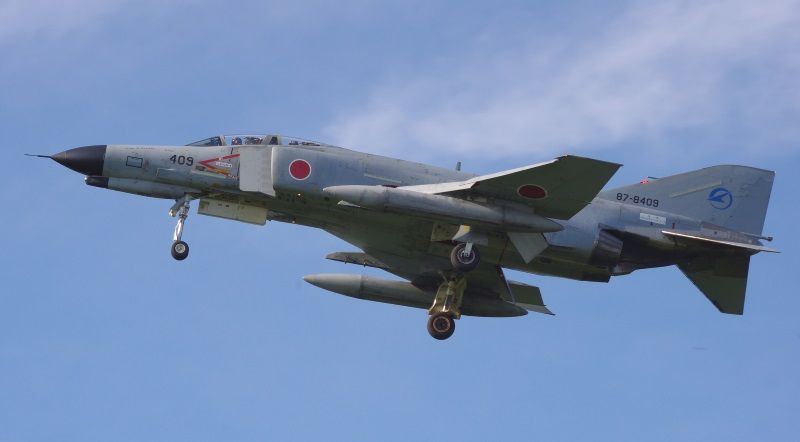
The JASDF also obtained 14 RF-4Es directly from the US, replacing RF-86F Sabres in the reconnaissance role. The RF-4Es were delivered in 1979 and 1980, and had the smoother nose contours of late-production RF-4Es.
* The JASDF initiated an update program for their F-4EJs in 1982. The update featured structural strengthening, reinstatement of inflight refueling capability, and a new avionics suite that included AN/APG-66J radar, used on the F-16, and the computer fitted to the JASDF's F-15Js. The updated aircraft were designated "F-4EJ Kai", where "Kai" stands for "kaizen" or "improvement." The first F-4EJ Kai flew on 17 July 1984, with initial service deliveries in 1989, and a total of 90 F4-EJs updated by the end of the program in 1995.
13 of the RF-4Es were given a similar update, with the original AN/APG-99 radar replaced by AN/APQ-172 radar. The updated RF-4Es were given the designation "RF-4E Kai".
17 F-4EJs were also converted to the "RF-4EJ" reconnaissance configuration, these aircraft carrying all their sensors in underwing pods. The RF-4EJs can carry a standard camera pod for tactical reconnaissance; a long-range camera pod; or an ELINT pod provided by the French firm Thomson-CSF. The JASDF phased out the last of their Phantoms in 2020.
* South Korea received a total of 92 ex-USAF F-4Ds from 1969 through 1988. Under the PEACE PHEASANT program, the Republic of Korea Air Force (ROKAF) also received 37 new-build F-4Es beginning in 1978, as well as 66 ex-USAF F-4Es, for a total of 103 of that variant. The final new-build South Korean F-4E was the last Phantom produced in Saint Louis. In addition, the ROKAF inherited 12 RF-4Cs that had been operated by the USAF in South Korea.
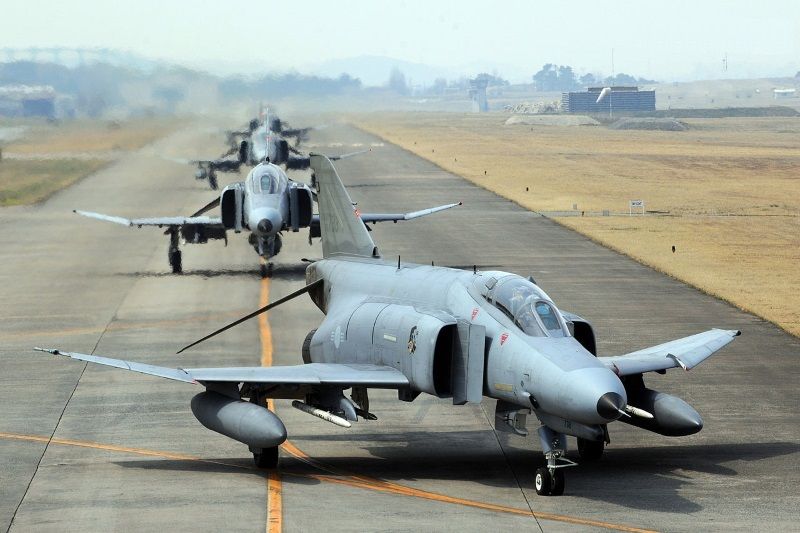
Although the ROKAF issued a requirement for a Phantom upgrade along the lines of KWS-ICE in 1993, they didn't follow through on it, since the service was more focused on getting their F-16 force up to strength. ROKAF Phantoms were given structural strengthening, and the service did obtain eight AN/AVQ-26 Pave Tack targeting pods in 1987, wiring up some of their Phantoms for carriage of that gear. ROKAF Phantoms were later modified for carriage of the Rafael AGM-142 Raptor (Popeye) ASM. The ROKAF Phantoms were retired in 2023, replaced by Boeing F-15K fighters.
BACK_TO_TOP* The Iranians obtained 32 F-4Ds beginning in 1968, and later acquired 180 F-4Es and 16 RF-4Es, all new-build aircraft, under the PEACE ROLL program. More were on order when the Iranian Revolution cut short further acquisition of US weapons, at least in principle. The under-the-table "Iran-Contra" arms-for-hostages agreement with the US in the mid-1980s resulted in the sneaky transfer of at least 23 ex-USAF F-4Es through Paraguay, along with spares and other weapons.
The Iranians were fighting a bitter war with the Iraqis at the time and found such business with the "Great Satan" very useful to their ends, since Iranian Phantoms were an important weapon in the war. One Iranian F-4E was shot down by Saudi F-15s during the conflict when it strayed into Saudi airspace. The fighting imposed a lot of wear and tear on the Phantoms, with at least half the fleet lost or grounded.
The Iranian F-4s languished for some time, but from the turn of the century they have been refurbished and ugpraded for the attack and anti-ship role, kept flying by the clandestine acquisition of spares, as well as considerable local ingenuity in the reverse-engineering and manufacture of such spares.
In fact, Iranian industry has been energetic in keeping their Phantoms in combat-ready condition, providing improvements to the aircrafts' radar systems, as well as substituting or incorporating more advanced Chinese-made avionics; adding countermeasures such as chaff-flare dispensers; as well as qualifying the F-4s for new weapons, notably the Chinese C-801 and C-802 anti-ship missiles, plus Iranian-designed munitions, and the Russian R-73E AAM -- stocks of Iranian-refurbished AIM-9J Sidewinders having run low.
From 2008, a service-life extension program was performed on 64 F-4Es and a few F-4Ds, with work performed on some new avionics, plus a retractable inflight refueling probe. Iranian F-4s performed strikes on Islamic State militants in Iraq from 2014, and escorted Russian strike packages. Iranian Phantoms are likely to remain in service well into the 2020s, or possibly even the decade after that.
* Egypt received 34 ex-USAF F-4Es in 1979 under Operation PEACE PHAROAH, as a reward from the US for signing the American-brokered peace treaty with Israel. US President Jimmy Carter had originally offered Northrop F-5E/Fs, but Egyptian President Anwar Sadat replied that Egypt wanted more formidable aircraft.
The Phantoms were supplied with a stock of up-to-date Sidewinders, Mavericks, and most significantly much-improved AIM-7F Sparrow III AAMs, providing the Egyptian Air Force (EAF) with a potent long-range AAM capability. EAF pilots were given a quick flight instruction course at George AFB in California.
Providing the Phantoms to Egypt was a politically astute move, since at the time the Phantom was still recognized as a first-line combat aircraft. The Egyptian public saw it as a sign that the US wanted to treat Egypt on an equal basis with Israel. The Phantoms were also the beginning of a process that would convert the EAF from an air force based mostly on Soviet equipment to one based mostly on US gear.
However, the Phantom was not popular with the EAF. EAF pilots had traditionally flown smaller, more agile aircraft like the MiG-21 and the Dassault Mirage 5, so the hulking Phantom was a bit much to swallow. When President Sadat asked one EAF officer what he thought of the F-4E, the officer replied: "Excellent bird, but it maneuvers like a loaded truck, Mr. President." EAF maintenance personnel had an even harder time with the Phantom. They were used to dealing with Soviet types, which were generally designed to be simple and easy to maintain, and the complicated F-4E was a pain. Maintenance was also complicated by a lack of funds for spare parts.
About 80% of the EAF's Phantoms were soon grounded and Egypt considered selling them to Turkey, but in 1982 the USAF sent an advisory team to Egypt to help get the situation under control. Egypt was much happier with the Phantom after that, and even acquired seven more F-4Es in 1988 -- though by that time, the EAF was mostly committed to the F-16 as their first-line fighter. Apparently three more F-4Es were also provided as attrition replacements. At last report, the bulk of the EAF's Phantoms were still in service, having received some structural strengthening and a few minor improvements.
BACK_TO_TOP* The list below provides a breakdown of Phantom production by variant:
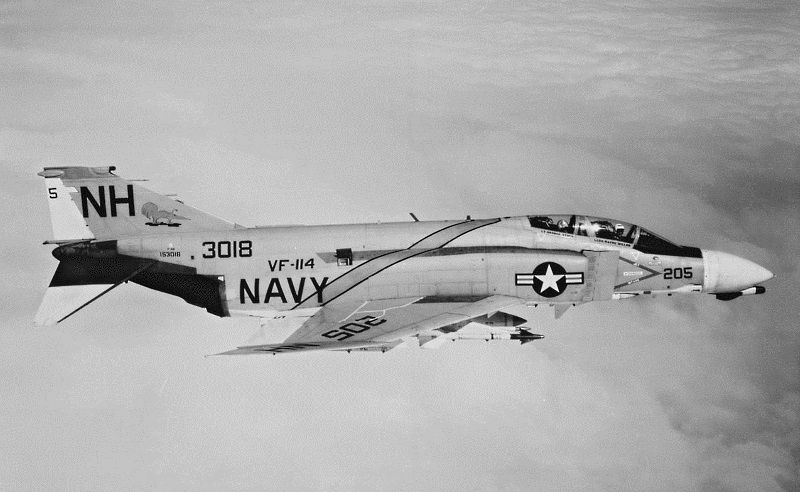
The QF-4 and specialized conversions are not discussed here, in interest of simplicity. The list below provides a breakdown of Phantom production by users:
* One minor item that didn't fit neatly into this document was the fact that the Royal Australian Air Force (RAAF) was also a Phantom user -- if only for a short time. The RAAF had ordered the General Dynamics F-111C to replace their aging English Electric Canberra bombers, but deliveries of the F-111C were delayed. As an interim solution, the US loaned them 24 F-4Es in 1970. The RAAF was delighted with the F-4Es and there was even a push to cancel the F-111C order, but the Australian military's defense requirements dictate operation over wide areas of the South Pacific and the Indian Ocean. The Phantom didn't have adequate range to do the job without also buying and operating tankers. The Phantoms were returned in 1973, less one that had been lost in an accident, after the F-111Cs began to arrive.
Another story that didn't quite fit in with the rest of the document was the strange twists of Randy Cunningham's postwar career. After mustering out of the Navy in 1989, he went on to run in California for the US House of Representatives, where he served eight terms. His political career crashed abruptly in 2005, when he confessed to taking millions of dollars in bribes from defense contractors. There were those who took some satisfaction in his fall. Some of his Navy colleagues had found him arrogant even by the standards of fighter pilots, and his work in the House of Representatives had been punctuated by outbursts of over-the-top abuse against those who did not meet with his approval.
* Although I likely saw the Phantom a number of times when I was a youngster, I have only one distinct memory of it. It was a cold, socked-in day with soggy overcast and one flew directly over my head at low altitude, appearing literally like a "phantom" out of the murk, to then disappear again. I was thoroughly impressed with the shriek of its twin J79s.
Apparently the F-4 acquired the nickname of "Rhino" during its career, though it is unclear just when this was, or who used it, and how much. However, there's no doubt where the nickname came from, since the hefty, angular Phantom certainly does suggest a rhinoceros. I recall a cartoon that successfully merged the figure of an F-4 with an angry rhino starting to build up into a charge, and the merger seemed perfectly plausible.
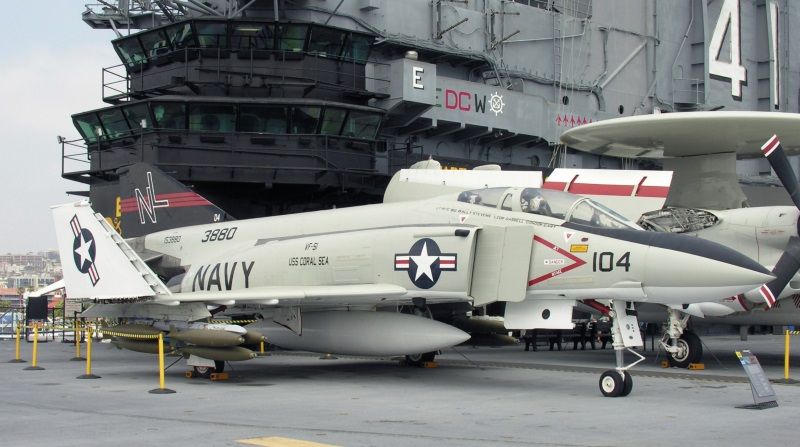
* There were the usual contradictions between sources for this document. Trying to figure out production quantities proved a chore. The figure of a total of 5,195 Phantoms produced seems pretty solid, as did the figures for most of the variants, but the F-4E in particular proved to be troublesome. That appears to be due to confusion over the numbers of F-4Es built for the US; those built for foreign service; and those passed on from US service to foreign service. The confusion is compounded by Japanese F-4EJ production, due to ambiguities between the Japanese Phantoms that were supplied from the US and those that were actually built by Mitsubishi.
I arrived at the 1,387 quantity of F-4Es by a process of subtraction of seemingly reliable production quantities of other variants from the overall total. Following that exercise, I got the quantity of 993 in USAF service by subtracting F-4Es built for foreign service from the subtotal. All my tallies seemed to add up in the end, and so I feel reasonably confident of the numbers of new-build aircraft. I don't feel as confident in numbers of aircraft passed on from one service to the next -- but in the absence of any clear way to check, or for that matter any strong reader interest in the subject, the numbers given here can be accepted as a fair approximation.
Another set of discrepancies in sources were the dates of various milestones in the initial development of the Phantom. Given the complexities of government contract processes, the odd thing is that all the sources could be technically correct. I decided to only cite a few specific milestones, such as date of first flight, and otherwise provide general timeframes.
* Sources include:
A few comments were also taken from an extensive web document by aviation enthusiast Joe Baugher.
* Illustrations details:
* Revision history:
v1.0.0 / 01 jan 02 v1.0.1 / 01 aug 02 / Review & polish. v1.0.2 / 01 aug 04 / Review & polish. v1.0.3 / 01 jul 06 / Review & polish. v1.0.4 / 01 may 08 / Review & polish. v1.0.5 / 01 apr 10 / Review & polish. v1.0.6 / 01 mar 12 / Review & polish. v1.0.7 / 01 feb 14 / Luftwaffe retirement, final delivery of QF-4 target. v1.0.8 / 01 jan 16 / Review & polish. v1.0.9 / 01 jan 18 / Review & polish. v1.1.0 / 01 feb 20 / Review, update, & polish. v2.0.0 / 01 jan 22 / Illustrations update. v2.0.1 / 01 dec 23 / Review & polish. (+)BACK_TO_TOP
